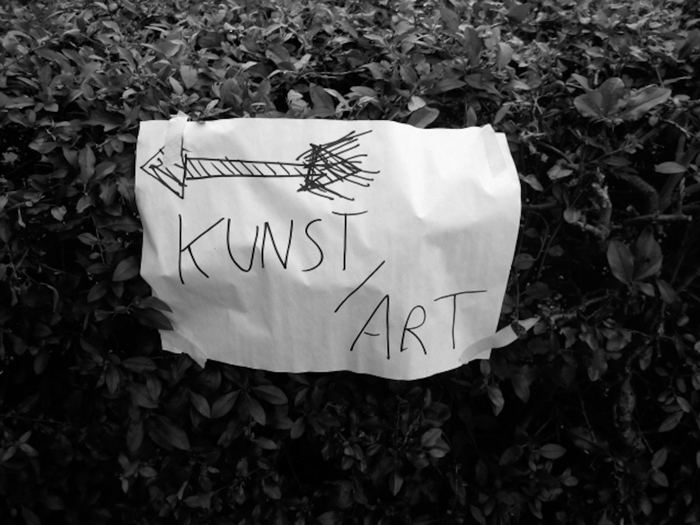
Typical art tour signage.
For two weeks in June, we—an artist and an art historian—embarked on the Grand Tour with the rest of the mobile art world. Faced with a smorgasbørg of checklists, maps, ticket stubs, catalogues, and digital imagery collected on the Grand Tour 2007 of art extravaganzas, we thought it might be useful to make a record via a collection of observances and recollections, in opposition to a more objective or conclusive position. We made a modified art journey, skipping the art fair in Basel, and adding Dusseldorf and Berlin to the list. We each retired a pair of shoes, added over 8 kilos of books to our already bursting koffers, jumped on last-minute, overnight trains, and consumed, for the first time, novelties ranging from the perfect aperitif Gingerino to less praiseworthy, traditional Berlin hotdog soup.
When on the tour, we frequently met people spouting negative reports. Traversing so much physical space devoted to contemporary art packed with so many people entailed trials and tribulations. Logistical hurdles can lead to feelings of disaster and disappointment. Friends and acquaintances met on the trail suggested that Documenta was “confusing and bad,” Münster was “miserable,” and Robert Storr’s Arsenale was “something to miss.” These words of wisdom were noted and largely ignored; an open mind was key to survival.
The following is a compilation of descriptive moments that characterize, in no comprehensive way, our experience of the Grand Tour. For this narration, our vacation slides have been shuffled: we opt to order the trip thematically rather than chronologically.
Labyrinths and Detours I
While Venice’s labyrinthine alleyways and dead ends are well mapped, if not navigable, the tangled paths of Kassel and Münster came as greater surprises. Documenta 12 curators Roger M. Buergel and Ruth Noack intentionally spin the viewer around and set her loose inside rambling temporary structures and eighteenth-century castles, as well as more traditional spaces, all without help of contextualizing wall texts or explanatory introductions. Rumors spread through the pavilions that the scores of empty wooden chairs were to hold the 1001 Chinese visitors comprising Ai Weiwei’s Fairytale, that pushing the button on Andrei Monastryski’s installation Goethe did something (it did ring a bell in a different room), and finally not to bother searching for chef Ferran Adrià’s contribution, (it was, as the map curiously diagramed with an inset just south of Schloss Wilhelmshöhe, in Spain). (This would not be the last time we found ourselves in the wrong city.) The absence of the customary crutch of explanatory text was the curators’ conceit, as they explained in a recent Artforum interview.1 They purposely did not provide wall texts or “finished ideas,” compelling the viewer to compose her own. This freedom is somewhat at odds with the firm curatorial hand, firm at least in the specificity and eccentricity of their tastes.
Where direction was given, it was in the form of associative constellations of thematic and formal elements in the work: Tanaka Atsuko’s Calendar, a collage of text overlaid with numbers ticking off the days until she could leave her hospital bed in 1953, with Nasareen Mohamedi’s Diaries (1970) which seems to do the opposite, printing text over a numbered calendar. More lyrically and successfully than any other curatorial moment in the exhibition, Louis Jacob’s 159-panel collage, Album III (2004), slowly walks the viewer through endless permutations of pop cultural forms. Rather than any unifying motif, it was the artists themselves who became the threads stringing Documenta 12 together. For those truly lost in the sprawling exhibition, triangulating one’s position by John McCracken was an option—no fewer than 13 of his works were spread throughout the halls.
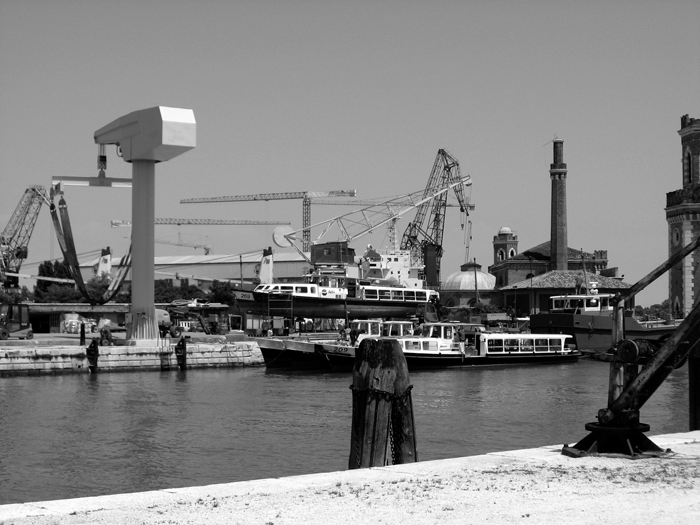
Looking at the wrong thing: Average Venetian industrial site appears rather Oldenbergian when viewed from the Arsenale.
Death Masks at the Venice Biennale
Storr’s colossal exhibition at the Biennale made Documenta’s Aue Pavilion look petite and manageable. The first half of the exhibition, located at the Arsenale, immediately confronted one with Storr’s idea of what it means to feel with the mind and think with the senses: that is, to contemplate the war. To be sure, much of the work was moving, conceptually and affectively. For example, Gabriele Basilico’s photographs of bombed-out Beirut against gray skies (1991) and Charles Gaines’s 1997 electronic diorama of a passenger jet crashing into a New York-like city throw history into disarray. Both of these prescient works (it’s hard to imagine that they were made in the ‘90s) provide further evidence to our sneaking suspicion that history is repeating itself. While the war-related work is tiring in its sheer volume—defecating skeletons, Christ tacked to a B-52 bomber, and photos of wounded and abraded CPR dummies—there are works that truly capture the embodied thought and conceptual affect Storr is striving for. Neil Hamon photographs battle reenactors of wars spanning the centuries, evoking the curious desires of the universal soldier to forever live and relive past glories and atrocities. Paolo Canevari’s Bouncing Skull consists of a video projection of a young boy in the shadows of a blast-torn, former Serbian army headquarters. The boy balances and bounces a human skull on his foot like a soccer ball, making us wonder, amidst so much violence, does the memento mori lose its power to make us reconsider our actions and ethics?
For the best death and destruction art, we hiked over to the Giardini’s national pavilions. The Netherlands (Olanda to the Italians) presented Aernout Mik. His new work, Citizens and Subjects, is a multi-channel video installation of police training exercises in the handling (and man-handling) of refugees, interspersed with news footage and his own restaging of theses drills. As the actors uneasily take up and push against their assigned roles as refugees and response teams, the fungible definitions and relationships that support the dichotomy between citizens with rights and subjects of power slip ever further into the realm of the fictional. The Russian pavilion provides one of the most entrancing works of the entire Biennale. AES+F GROUP’s Last Riot is a 3D animated and live-action battle in a snowy video game world between interchangeable armies of shirtless, acne-specked, multi-racial teenagers hovering and twitching in the moment right before they bloodlessly bludgeon each other with baseball bats, golf clubs, and swords. The three-channel work simultaneously shows each character in positions of power and victimhood, surrendering his or herself into restraints that appear at the same time as romantic embraces. The erotic fluctuation between victor and conquest cuts right to the ambivalences hovering beneath the surfaces of conflicts in which enemies mutually constitute and eradicate each other, desperate both for the other’s survival and destruction.

Michael Asher’s work in its 40th year waiting calmly to be found; When we were there it was in an alley near the museum.
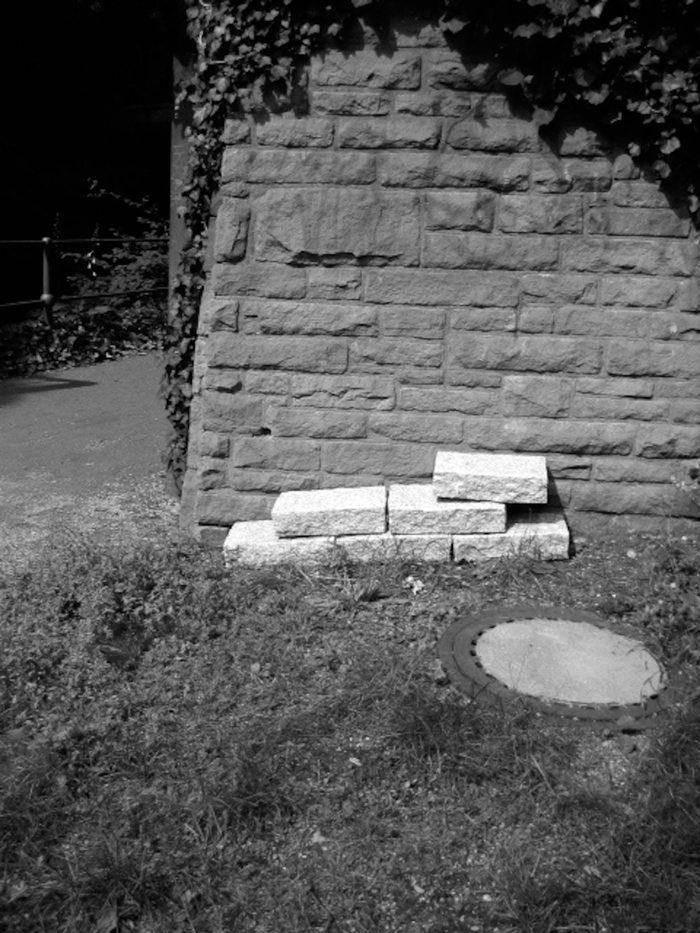
Metzger’s Aquivalenz-Scattered Stones: a bonus siting while on Janet Cardiff’s listening tour.
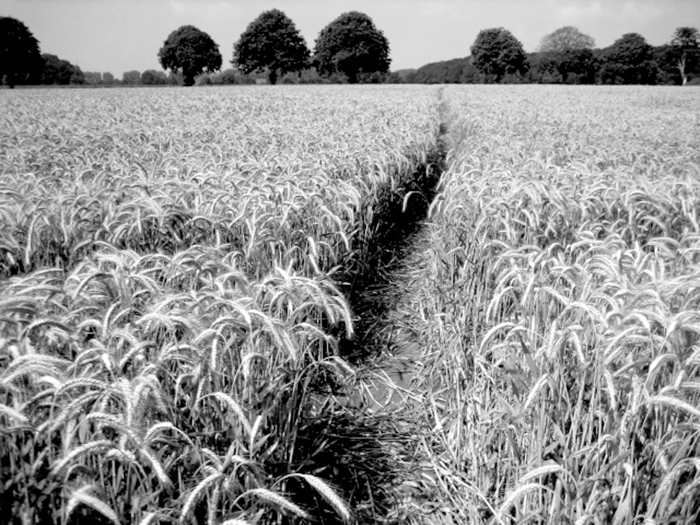
Image of Pawel Althamer’s Sciezka (Path), taken while waist-high in wheat and ankle-deep in mud.
Labyrinths and Detours II
In Münster, the loose accuracy of the Skulptur Projekte 07 maps did not frustrate, but functioned as a treasure map for the group show spread across the entire city. Early in our first morning of biking around Münster’s concentric, circular streets, we stumbled upon Dominique Gonzales-Foerster’s Roman de Münster (A Münster Novel). Gonzales-Foerster’s sculpture reproduces work from the past and present Skulptur Projekts in miniature, providing not a map, but a set of visual cues for the rest of the search. While rendering the sculptures almost unbearably cute (and in some cases greatly improving upon the originals), Roman de Münster manages to capture the grand scope of public art in Münster by reducing it to a single vision. But even with Gonzales-Foerester’s guide, the sculptures are not easy to find. Michael Asher’s reprised Information Münster (Caravan) moves about the city (though in this fourth iteration, the work grapples with parking laws, or a politics of stasis rather than mobility). Gustav Metzger’s Aequivalenz—Scattered Stones, which we saw by chance while following Janet Cardiff’s 1997 tour, is a daily deposit of varying arrangements of cobblestones at shifting locations throughout the city. The temporary monuments reference the English bombing of Münster during the Second World War. (Unlike Berlin, a city which preserves the fragments of its shattered past, Münster’s buildings were restored to their pre-war perfection, erasing the wounds of combat and casualty, the city reinventing itself in its own image.) Metzger’s teetering piles of cobblestones reunite Münster with its ruins, at least for 107 days.
The migrations of these works added to the thrill of the scavenger hunt. Several works in this year’s exhibition rely on our mental images of hedge mazes, but fail to lead one astray—Rosemary Trockels’s Less Savage than Others, a Matta-Clark like cut through tall dense hedges frames a lone high-rise across the lake, and Martha Rosler’s tiny, tangled bamboo path, one of her Unsettling the Fragments installations, actually follows a rigid and reinforced pathway. Successfully drawing us in, Pawel Althamer’s Sciezka (Path) led us meandering for near an hour through the corn and wheat fields surrounding the city, passing whooping storks, family farmhouses, and tiny hidden ponds. We initially thought the piece would be a re-traceable Richard Long, but Althamer’s sculpture was the jewel of Skulptur Projekte Münster 07. It condensed the entire experience of the show, and potentially our whole grand tour, into a single work. Skulptur Projekte is an experience, one both active and surrendered to, which leads the viewer on a goose chase through the industrial, cultural, commercial, and agricultural layers of a city.
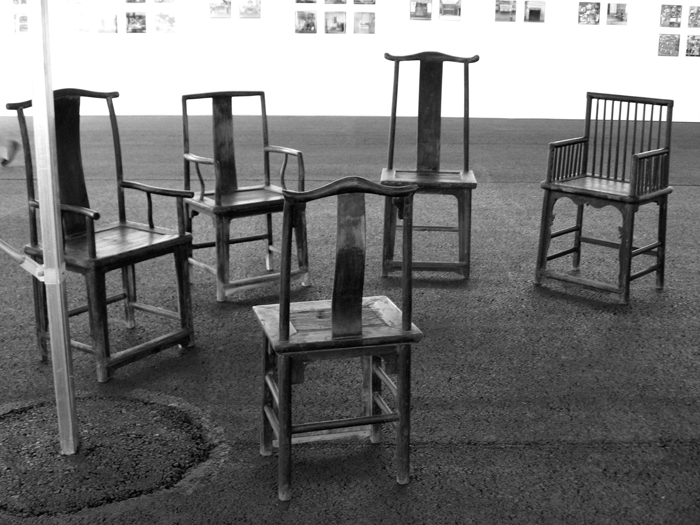
Chinese chairs waiting for enlightenment in the Aue Pavilion.
Design Over Reach
At Documenta 12, the exhibition furniture sometimes threatened to overshadow the art. Some examples: Joanna Billings’s benches, the 1001 Chairs of Enlightenment, and Trisha Brown’s jungle gym. Yael Bartana’s Summer Camp (a riveting video of the rebuilding of a destroyed Palestinian assembly hall that is part biblical film, part propaganda) was nearly rivaled by its accordion-like, aromatic pine viewing structure, but it was able to balance its brilliant housing.
In a number of spots, the architectural space itself overpowered the artwork. James Coleman’s magnificent video screening room seemed a perfect setting for the debut of a new, large-scale project from him. Unfortunately, the video, entitled Retake with Evidence, a bizarre and confusing film of a ragged Harvey Keitel pacing among Greek ruins, did not complement the room.2 In a few cases, the dramatic settings were in balance with their tenants—the Neue Galerie’s low-ceilinged basement catacombs, painted a bright blue by the curators, seemed perfect for the unearthing of an old favorite, Eleanor Antin’s The Angel of Mercy (1977).
Documenta’s temporary Aue Pavilion, designed by Parisian architects Lacaton and Vassal, was a total disaster, described as a “catastrophe” in the New York Times.3 (Holland Cotter also used the word “cheesy” to describe the curtains. This surprised us because, like the verb form of “impact,” we had assumed “cheesy,” when not describing food, was not a word fit for print in the Times.) In press materials, this pavilion was compared to the Crystal Palace (of the London Great Exhibition of 1851), but for us, it recalled a bad dream of a bad art fair. The sprawling, undivided, poorly lit space, rumbling sound, and dark red floor made it an incompetent art housing. The disappointing reality of the pavilion is an example of the type of over-reach that was pandemic to the curatorial statements. The ideas were huge and potentially engaging, but the physical manifestations of the curatorial claims did not meet expectations. Another clue to the public’s disappointments; the three questions put forth by the curators to provide guidance in navigating the exhibitions were often the butt of jokes: Is modernity our antiquity? What is bare life? What is to be done?
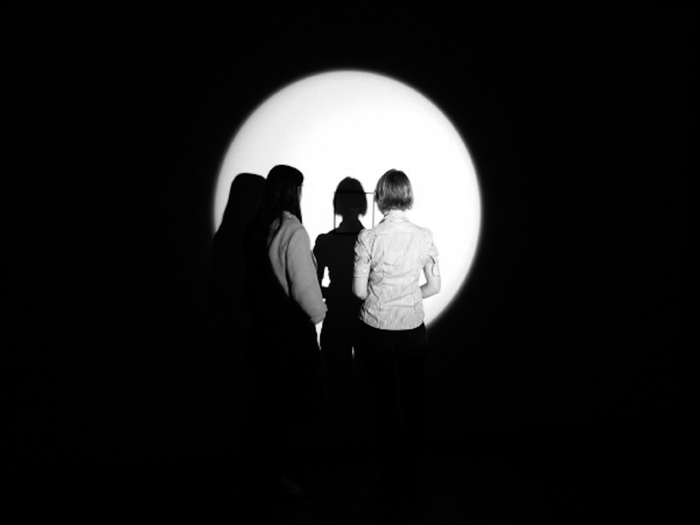
This column’s authors stepping into the light to view Gonzalo Dias’ Ellipsis.
Flashlights
Along with wall text, Documenta 12 did away with white walls and bright light. We groped and shuffled around in the dark, cavernous pavilions and museums, sometimes straining to see delicate drawings against dark walls. Although often obscuring, the low lighting and odd colored walls did in some cases pleasantly surprise, as in the case of Mary Kelly’s theater-lit The Ballad of Kastriot Rexhepi (2001) and glowing, back-lit Love Songs, a series of tributes and reenactments of moments from the feminist movement of the 1970s. (We were, however, slightly troubled by the uneasy bedfellows of feminist art and pink walls.) Perhaps the curators were staging an elaborate set up for Gonzalo Díaz’s Ellipsis, a spot-lit, etched panel of (German) text tucked into a guarded room. The text is only visible when one blocks the blinding light. When we entered, the other two people (only four were allowed in at a time) hoped that we could translate. The translated text, “To come to the heart of Germany only to read the word art under one’s own shadow,” could read as a comment on the unlikely destination of Kassel for an art-world extravaganza, drawing thousands in to see nothing but their own shadows, and in the context of the exhibition it functions as a joke—the one brightly lit work that needs to be in darkness to be seen.
Crowd Surfing I
The public party for Documenta was held at the Schloss Wilhelmshöhe. It was raining hard and had been for several hours when the party was to start. We stayed back in town, in a warm cave of an Egyptian restaurant underneath the Museum. After following our Egyptian fare with schnitzel at a Denny’s equivalent, we eventually boarded an overcrowded tram headed to the castle. Already soaked, we walked with the crowd up the paved path to the castle and entered a field of mud, where groups of people huddled under the awnings of bars and food stands, shivering. Slowly, far across the field, from the woods, a line of moving lights made its way down towards the crowd. This undulating line of light was Mary Kelly’s opening night happening, and though it was nearly swallowed by the rain and the mud, it provided some guidance, warmth, and significance to the evening. If we were closer, we would have seen that the line was composed of a 100 women, each with a triangle of lights attached to their bodies. From our vantage point, the line disappeared into the crowd like an apparition. As soon as the lights were gone, the rest of the art-world people disappeared too, and we were surrounded by Kassel’s collective of local partyers. We hustled back to the tram headed for town.
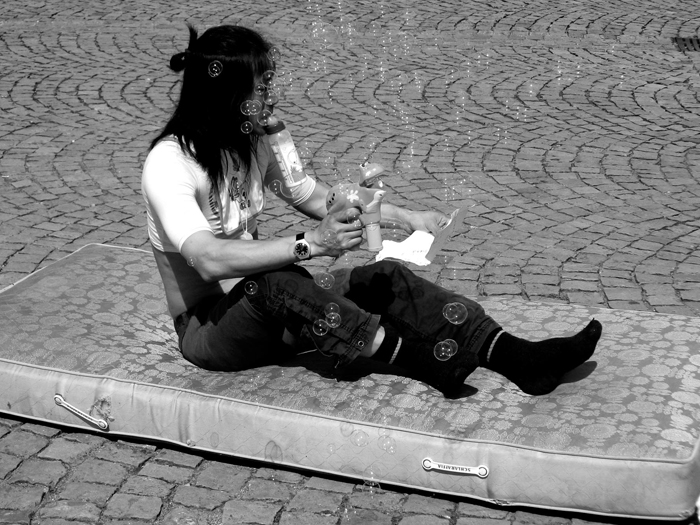
Collateral art events sometimes gained our full attention.
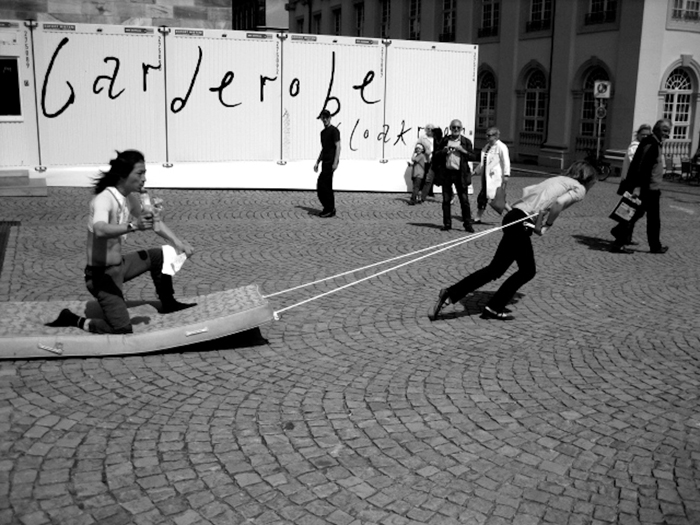
Here, Kris pulls a piece of performance art.
Collateral / Looking at the Wrong Thing
A consequence of all art all day is that the lines begin to blur. With so much art around us, how were we to distinguish between the sanctioned works and the ersatz Oldenbergs in the form of giant scales and slings on the banks of Venice’s canals? Is that man on the street a performer, or merely a lunatic? Is that a sculpture or a homeless encampment? The distinctions became less and less clear as we made tracks across Europe. To be sure that what one was looking at was art, it helped to follow the cameras. The Biennale organizers made life easier by outfitting us with maps and a catalogue of all the “Collateral” events surrounding the main show. Whether they intended the appellation to indicate the supportive nature of the off-site works, as tokens that sanctify and secure the stature of the events at the Arsenale, or as “collateral damage,” remained somewhat ambiguous.
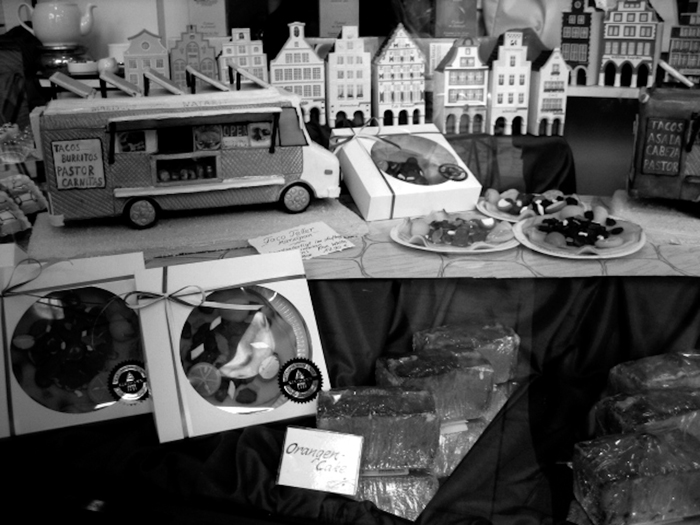
Pae White’s tacos “hiding” in the window of a marzipan shoppe.
Begging for More Art
In Münster, to be sure that we had found Dore Garcia’s The Beggar’s Opera and not just any man on the street, the actor in Garcia’s “continuous performance in public space, barely distinguishable from daily life,” produced his number from the map to make it, in his words, “official.” We also struggled for a while to find Pae White’s taco van, only to eventually discover it in a confectioner’s window, made of marzipan. Marzipan tacos were for sale and reasonably priced, but were we supposed to eat them?
Crowd Surfing II
It was the middle of the afternoon and we had just returned from a trip to the Schloss Wilhelmshöhe, or maybe we were on the way there, and outside of the Museum Fridericanium was a man on a single mattress. He had long hair, was wearing a half-shirt, and he was taking off his pants. He was surrounded in a fog of bubbles created by his pink frog-shaped bubble-making gun. He had a baby’s bottle in his mouth filled with milk. He had a sign around his neck. We approached him. The sign read, in both German and English, something to the effect of “Please pull me.” Attached to the mattress was a looped rope with a harness at the center. Kris stepped up to the rope, putting the harness around her waist, and started dragging the mattress, as a horse would pull a carriage. The “vehicle” moved slowly on the cobblestones, as Kris showed signs of exertion. She pulled the man on the mattress for a few yards as the gathered crowd took many pictures. This kind of sideshow spectacle was not uncommon to the Grand Tour.
Contemporary Pain
In Berlin, avoiding the pervasive theme of torture and torment connected to the city’s Checkpoint-Charlied past can be difficult. On a Sunday, when the stores and galleries are closed, it was impossible. We thought we would be safe at the Hamburger Banhof, the contemporary art museum, which offered a Matthew Buckingham show and architecture the guidebook claimed we would find interesting. We arrived and saw the main exhibition was called Schmerz (pain). The Francis Bacon painting on the exhibition map and the elaborate wall text informed us the show would examine pain from a number of different angles (sections included Views of Pain, The Ecstasy of Pain, The Time of Pain, and The Expression of Pain). It seemed torture and torment also reigned at the Banhof. We bravely stepped into the exhibition to receive our due.
We were first met with Bruce Nauman’s aggressively annoying Clown Torture (1987) video, the two monitors facing off beside a screening room with a severely disturbing Peter Campus video of close-ups of initially indeterminate internal body parts. Across the way was a compilation of William Kentridge videos, work that we generally find incredibly painful in its romantic and didactic nature. Beyond this trio was a large room with a group of intolerable Anselm Kiefer artworks—a gray airplane with dried flowers attached to the wings for reasons unknown, an over-sized gray bookshelf of gray books—and a severe Richard Long rock sculpture titled Berlin Circle. We thought we would find relief by slipping into a side gallery housing a tribute to Jason Rhoades, titled There is Never a Stop and Never a Finish, culled from the collection of Friedrich Christian Flick. This unbelievably long hallway led to, alas, more pain. Once within the context of pain, everything in the museum became pain-filled. Rhoades’ recent death was only one factor; the work of the other artists in the context of Rhoades, and all of them juxtaposed beside Schmerz, encouraged a very limited reading of all of the work in the whole museum. The abjectness, the excessiveness, the messiness, it all became flat. It became pain, inner pain and physical repulsion, quickly leading to our own revulsion.
The Matthew Buckingham exhibition didn’t offer any reprieve either. The most interesting piece, a new video titled Everything I Need, about a lesbian Jewish psychoanalyst named Charlotte Wolf who fled Berlin in the mid-30s, could only be read as another story of torture and pain.
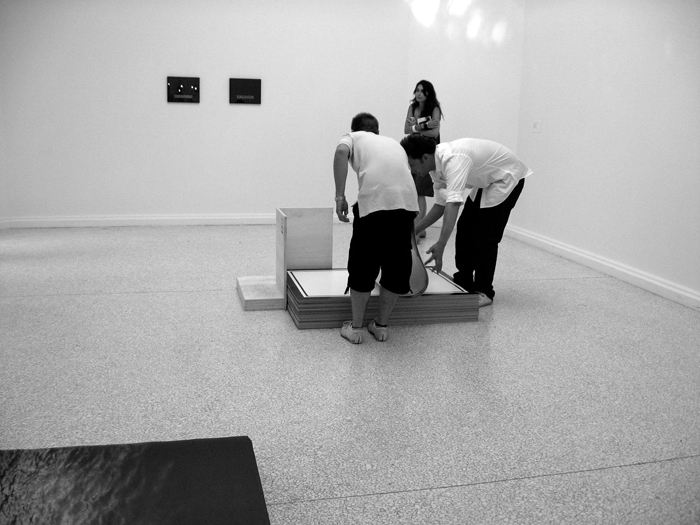
Restocking free: the staff at the USA Pavillion re-fills the Gonzalez-Torres stacks.
Ghosts
Besides the literal evocations of death in the thematic content of the shows at the Venice Biennale, there were several specters hanging over the show. The second installment of Storr’s exhibition, nestled in the zoo-like compound of the Giardini, had the otherworldly power of transporting us into the galleries of MoMA, walking from the Anselmo room, to the Rymans, Richters, Kellys, and Naumans. These historic names, among many others represented in the galleries, seemed to hover over the lesser-knowns housed at the Arsenale. They were among the first to take up the project of thinking with their senses and feeling with their minds, but now appeared so distant, abstract and above the fray of their literal-minded and narrative progeny. Above all, Sol Lewitt’s two wall- sized drawings, Light to Dark and Dark to Light were especially poignant. While his drawings have since the beginning been installed by others, never has this authorial absence been so emphatically present. The drawings, each composed of millions of tiny marks, are inverses. The first begins from a bright white center and fades to a dense black at the corners; the second is just the opposite, figuring a dark center that radiates and fades to an unmarked white at the fringes of the wall. The reversal of the facing drawings is complimentary to LeWitt’s practice as a whole: by leaving directions for others to execute, LeWitt manages to resurrect himself, to make himself, thankfully, ever present.
The most obvious shade haunting the pavilions was the ghost of Felix Gonzales-Torres, the American representative. Eleven years after his passing, Gonzales-Torres found himself installed amongst all the up and comers. His work, like that of LeWitt’s, scripts endless reiterations of his past work. The piles of prints and candies, continually exhausted and refilled, make themselves and their author ever present. Saving the United States’ pavilion for last we witnessed something better left unseen, the docent-priestess restacking the posters and replenishing the candy, making sure that no one notices that even a single day has passed.
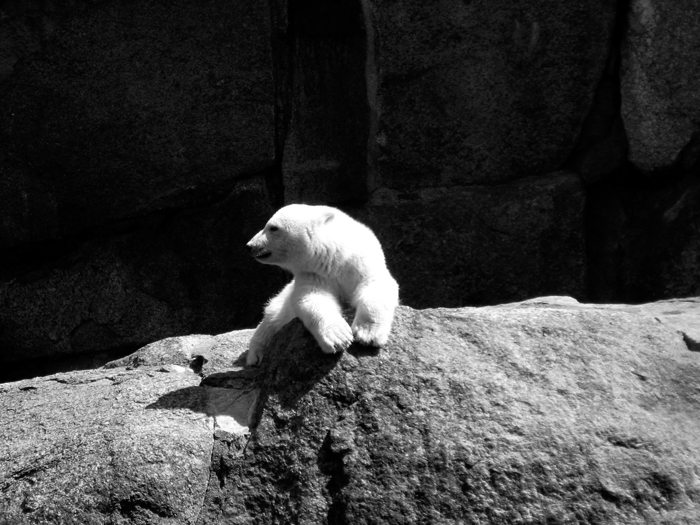
Bear life: Knut and the anonymus black bear.
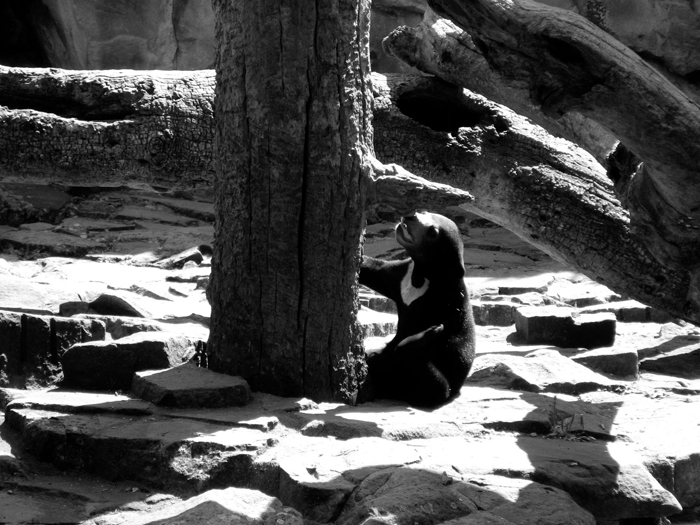
Bear life: Knut and the anonymus black bear.
So what are we supposed to look at? Bear life.4Knut, the world’s cutest animal, rescued from death, was another unofficial stop on our Grand Tour. A media star in Germany, the toddler polar bear was rejected by his mother this past spring and saved by zookeepers from starvation after a series of protests by Leonardo DiCaprio and other lesser known figures. At the zoo, in front of the smaller Eis Baren enclosure, it was undeniable—Knut was cute. But in the enclave beside him, a baby black bear and his mama stole the show, playing and posing with an enthusiasm that outshined the dozing Knut. Drawing the inevitable art-world parallel, it felt as if we had been directed once again to look at the wrong thing. Instead of finding satisfaction with the already established art-stars, we had continually found (though with not that much surprise) that some of the most successful and provocative works were to be discovered only through persistence and dedication to the hunt. The work put forth by some of the artists who were on our personal to-do lists, whether it be Coleman at Documenta, Emily Jacir or Sophie Calle in Venice, or Martha Rosler at Münster, often led to disappointment. The pleasant surprises and engaging work came from places that barely (bearly) made it onto the map.
Shana Lutker is an LA-based artist and the Assistant Managing Editor of X-TRA. She has known Kris for 11 years.
Kris Paulsen is a Ph.D.candidate in Rhetoric and New Media at the University of California, Berkeley. She is finishing her dissertation on real-time telecommunication in the arts. More about her work can be found on her website: www.kpaulsen.com.
